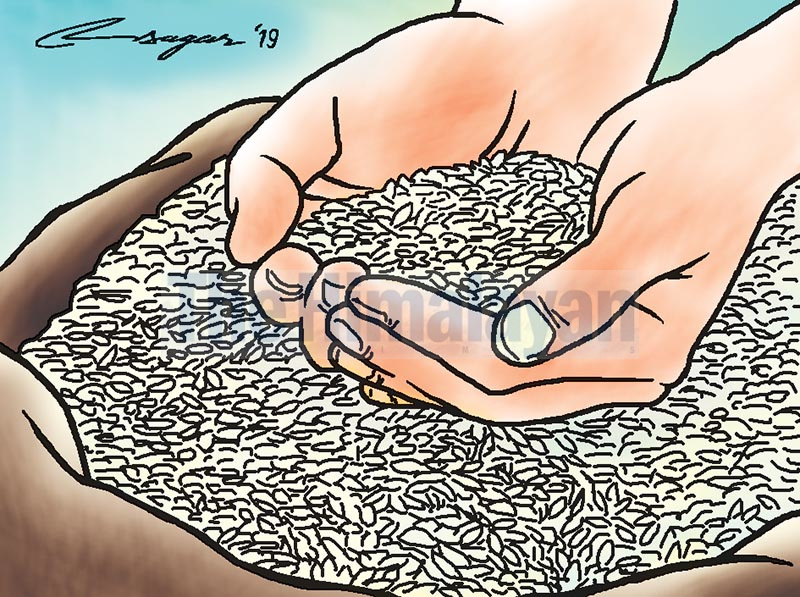Plastic rice rumours: No truth in them
Absurd news often gets extensive coverage in social media. Had it not been for the social media, ‘plastic rice’ wouldn’t have gained its current popularity. Similar cases of infection of fruit juice and tomato with the HIV virus have been reported in the past
Just when news about the entry of poisonous vegetables in Nepal is settling down, rumours of plastic rice are making the rounds of Kathmandu. Since the past few days, social media platforms like Facebook and Twitter have been flooded with rumours about the sale of plastic rice in Kathmandu. And without any proof, tips on distinguishing between real and plastic rice have earned thousands of shares on Facebook.
Some months ago, a complaint about the rampant sale of ‘plastic rice’ in the capital startled those at the Department of Food Technology and Quality Centre’s office in Babarmahal.
In July 2017, the Nepal Police had seized four trucks of rice from Sherchan Brothers Pvt Ltd, at Sano Bharyang, following complaints from the locals that it was selling “plastic rice”. The news not only made media headlines but also went viral on the social sites.
Kathmandu frequently encounters threats of contaminated food and toxic veggies in the market. But for a country where every household consumes rice twice a day, the rumour of ‘plastic rice’ is life-threatening.
Indeed this plastic rice scandal has been reported in other cities before Kathmandu. Similar kinds of reports have earlier emerged from Africa and even India, but all rumours proved to be fake after examination.
A couple of months ago, every Indian media was flooded with news about ‘plastic rice’ and hoax of a bio-war waged by China.
Such news coverage creates extreme panic in the public as it concerns the health of the people.
The plastic rice phenomenon actually began in 2010 when China experienced the Wuchang rice scandal, where dealers mixed unique chemical flavours in ordinary rice to sell it as premium brand rice.
In 2011, the Korean Times also reported that suppliers inside Shaanxi Province were engaged in marketing fake rice made by mixing plastic and sweet potatoes.
Mainstream news agencies were also involved in highlighting this plastic rice scandal.
In December 2016, the BBC as well as CNN had allegedly reported news about the plastic rice scandal in Nigeria. Later the Nigerian government dismissed the case.
As shown by various other cases, ‘plastic rice’ can never be a mass phenomenon because there is no profit in manufacturing plastic foodstuffs. From the economic point of view, it’s bad business to make such adulterated food as plastic is lighter than rice, and in trying to shape it to look like rice, the cost of production will outweigh the net benefit.
Also boiling plastic rice will yield nothing and can’t get cooked like normal rice.
So why would any company be foolish enough to produce rice adulterated with plastic? The term ‘plastic rice’ originated after a video scandal in China went viral in the media. The plastic rice hoax was backed by a video which showed people bouncing rice balls. Actually, when plastic products go through the recycling process, the end products look something like rice, so factory workers commonly call the stuff ‘plastic rice’, but it’s only used to manufacture plastic goods.
Besides, since the plastic rice hoax in 2011, no country has been able to provide any precise evidence to prove the thing is real. And nutrition scientists have also made it clear that plastic being non-biodegradable, there is no way it can be consumed.
It’s no surprise that thought-provoking and absurd news often gets the most coverage in social media. Had it not been for the social media, ‘plastic rice’ wouldn’t have gained its current popularity. Similar cases of infection of fruit juice and tomato with the HIV virus have been reported in the past.
Rumours about plastic rice defy any logic, yet they are almost turning into an epidemic on the social media.
It is not the grocers but some online media that are selling over-hyped stories of ‘plastic rice’.
Instead of celebrating the rumour, why don’t the media do some investigative reporting on this issue? When online media resort to such reporting, what difference will there be between public hearsay and news stories?






